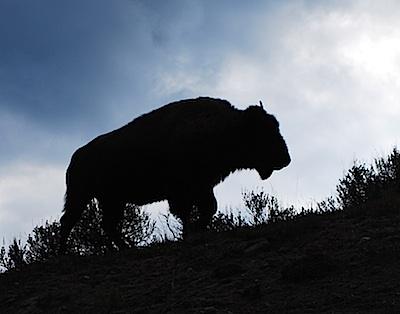
How Yellowstone bison are managed could change under a decision to reopen the 2000 Interagency Bison Management Plan. Marcelle Shoop photo.
The bison management plan that governs how Yellowstone National Park bison are managed when they leave the park could be revised under a proposal National Park Service and Montana officials are exploring.
Bison management in the park long has been a thorny and controversial issue. Some of the iconic animals carry brucellosis, a disease (which they contracted long ago from cattle) that can cause domestic livestock to abort their fetuses. As such, the livestock industry in Montana largely opposes Yellowstone bison leaving the park and heading into lower wintering grounds and calving grounds in Montana. Some of those bison are hunted, others are trucked off to slaughterhouses.
Now, with the parties agreeing to reopen the 2000 Interagency Bison Management Plan, everything likely will be on the table, including the park's work to maintain its bison population at a specific number. This past winter work to reduce the herd, which numbered roughly 4,600 late last summer, by 600 animals was highly controversial.
Al Nash, Yellowstone's chief spokesman, said today that efforts to maintain a specific bison population could change under a revised management plan.
"It could. Absolutely. That's something we could look at," he said during a telephone conversation. "Our management for population is under the current Interagency Bison Management Plan. It is a target population number that we agreed to under that 2000 plan. And it reflects the increasing likelihood that a larger number of bison might lead to greater migration outside park boundaries when we have significant winter weather."
Under today's announcement that the Park Service and Montana officials will consider revisions to the management plan, an Environmental Impact Statement would be crafted to explore any changes. To be taken into consideration during that EIS process would be "substantial new information and changed circumstances" since the 2000 plan took effect in 2001.
A notice will be published in the Federal Register later this year announcing the start of public scoping, which is an opportunity early in the planning and EIS process for the public, organizations, and other agencies to suggest issues and alternatives that should be considered by the NPS and the State.
"Of the many subjects that we might look at as we would develop a new EIS, we would look at population abundance, demographics of the animals, what habitat is out there and might be available, tolerance for people and bison and landscapes," said Mr. Nash. "All of those are areas that we might explore as we move into this process. The concept is to look at what we've learned and new infomraton, and determine if we should craft something to replace the existing IMBP."
The park spokesman said those who worked on the 2000 IMBP have been discussing possible changes to the plan for a while, and so have decided to formally explore the options.
"It's an idea that a variety of stakeholders have at least raised, if not promoted, for some period of time," said Mr. Nash.
Whether the resulting plan could prove more stringent, and so more controversial in some circles, than the current plan is an unknown.
"I think we have no preconceptions of what we might explore or what the range of alternatives may be," Mr. Nash said. "We and the state have come to the point where we both agree that we need to do a new analysis and not just rely upon the work that was done now almost a decade-and-a-half ago."



Add comment